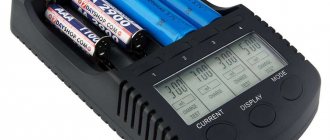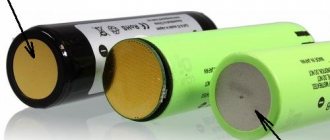The internal resistance of the battery is one of the battery parameters that must be monitored regularly. This will extend the service life of the battery and ensure uninterrupted engine starting regardless of climatic conditions. The indicator is influenced by many factors. You can find out the internal resistance yourself using one of the available methods.
Internal resistance is a physical term that combines ohmic resistance and polarization resistance.
What is the internal resistance of a battery
Internal resistance is a physical term that combines ohmic resistance and polarization resistance. For example, if the normal voltage of a new battery is 13 V, then if it is connected to a device with a resistance of 1 Ohm, it will drop to 12.2 A. This state of affairs contradicts Ohm's law, according to which 13 A should be obtained. This is due to the fact that only the applied load, but the battery itself has resistance. The reaction, as a result of which electricity is generated, is carried out with some inhibition.
A drop in current also occurs as a result of processes occurring inside the battery. There are also other factors that negatively affect the current generated by the battery.
Conductivity is never constant; the value changes depending on the current state of the battery and other factors.
Normal indicators
The internal resistance of a car battery should be 5 milliohms. You should focus on this indicator, although there are no standard values that would be considered exemplary. In any case, if the battery has already been used, but is not yet worn out, then the indicator should be in the range from 4 to 6 milliOhms.
A significant influence on the overall loss of physical qualities of the battery is influenced by the indicator that occurs in the working fluid, which is the electrolyte. It depends, in turn, on the ambient temperature and its concentration. As the liquid temperature decreases or the density increases, the current loss rate increases.
The capacity of the battery is to the same extent related to its internal resistance, and knowing this parameter, we can draw a conclusion regarding the capacity of the battery. For example, if it has decreased by 2 times, then experts conclude: the battery has lost up to 50% in capacity. These measurements determine its ability to provide a high starting current to the load. This is an inverse relationship: the smaller it is, the greater the peak current and power will be. The increased resistance causes a sharp drop in voltage at the battery terminals. Even if it is relatively new, it will not be able to produce a good peak current for the load.
Measuring the capacity of a car battery
In the process of general monitoring of battery current loss, this indicator is analyzed for its various components: leads, electrolyte, contacts, etc. If their value differs by more than 10% from the average indicator, then they must be charged separately, and if this does not bring success, then replace with new ones. At the same time, the average user does not own the special equipment required to evaluate this criterion. The most objective method of carrying out such measurements is a control charge for 10 or 20 hours, and then comparison with control data for voltage and discharge current.
In a word, the concept of internal resistance is a conditional value and its value constantly changes under the influence of operational factors. Therefore, when they want to get the most accurate calculations, they take as a basis not the value of internal resistance, but the discharge curves.
What does the parameter depend on?
The internal resistance is dynamic and is influenced by the following parameters: battery capacity, current, load, current charge level, temperature of the electrolyte inside the cans. The higher the load current, the smaller the parameter. The situation is similar with capacity. The higher it is, the lower the internal resistance of the battery.
Battery internal resistance curve.
Norm for 60 Ah
Ideally, we take a new battery that has not been sitting on the counter for long and is well charged.
In general, there are no exact indicators, there are only averages . But the smaller the battery capacity, the higher the resistance inside it.
This is due to the fact that the size of the plates is smaller - the contact area is smaller, so the indicator increases.
As many manufacturers write, the benchmark for a new battery with a capacity of 60 Ah is 4-7 mOhm. The average data will be in the table below
IMPORTANT - it is advisable to carry out measurements at a temperature of + 20, + 25 degrees Celsius, because in the cold the electrolyte freezes, and this indicator may increase
How to determine internal resistance
To check the parameter, there are special devices. With their help you can determine:
Device for measuring internal resistance.
- current value of internal resistance;
- the state of the battery under load when a certain amount of current is supplied;
- AC resistance;
- compare spectra.
Any of their instruments and measurement methods will allow you to determine the qualitative condition of a car battery, but you cannot talk about quantitative parameters, since the method does not allow you to determine how much longer the battery can last.
It is recommended to regularly measure battery performance with a multimeter. This way, purchasing a new battery will become a routine rather than an emergency purchase. According to statistics, internal resistance increases by 5% every year. If the dynamics is more than 8%, then the battery is not being used correctly, the driver will have to look for the reason, which creates an increased load.
The battery conductivity indicator is calculated taking into account the emf, current, and load. The value will vary depending on the following initial values:
- shape, dimensions of the battery;
- design of the basic components of the battery;
- condition of the process fluid;
- presence of alloying additives.
The electrolyte parameters have a special influence on the impedance: composition, density, temperature in the jars. Internal resistance depends on the type of battery. Acid-lead ones have a minimum resistance, the current does not exceed 2.5 kA, which is enough to start the engine normally.
The best of all is NiCd batteries. They are able to maintain high internal resistance even after 1000 charge-discharge cycles.
For NiMH, the impedance is initially higher and begins to increase further after approximately 350 charge-discharge cycles.
The characteristics of the Li-ion battery are in the middle between NiMH and NiCd power sources. During operation, the resistance does not increase. At the same time, Li-ion batteries completely degrade if they are not used for 2-3 years.
Several methods are used to measure the internal resistance of a battery at home.
AC supply
The simplest, but time-consuming, method requires the following equipment:
- constant resistor of a given value;
- limiting transformer;
- capacitor;
- voltmeter.
Using a digital voltmeter instead of an analog one dramatically increases the accuracy of measurements.
The method is simple, but not accurate enough, since there are factors that do not guarantee the correct assessment of internal resistance.
Measurement values take into account frequency and include active and reactive parameters. The accuracy of the readings is influenced by the peculiarities of the chemical reaction occurring in the battery banks.
Constant load method
Dependence of voltage and EMF during battery charging.
The most common method. Residential consumers use it more often than the AC supply method. After connecting the equipment, the load discharges within a few seconds. Internal voltage readings at the beginning and at the end of the procedure are recorded using a voltmeter. The obtained data is evaluated according to Ohm's law.
This method is not suitable for old batteries and will not allow a realistic assessment of the current technical condition.
Short pulse method
A relatively new method that offers the driver benefits:
Measuring internal resistance without removing the battery.
- testing is performed without removing or disconnecting the battery, which saves time;
- testing requires a short-term change in voltage, which does not affect the performance of the equipment connected to the vehicle’s on-board network;
- regular checking does not affect the performance of the battery;
- To take measurements, you only need a voltmeter (multimeter);
- at the same time you can compare the current readings with a new battery;
- The short-pulse method takes into account the current strength and the presence of short circuits in the network, thus it is possible to draw conclusions about the technical condition of the battery.
AC current
If you choose the simplest method, it will be the supply of alternating current.
In this case, you will need a certain device to measure the current internal resistance of a car battery. You need to arm yourself:
- a constant resistor with a certain value;
- limiting transformer;
- capacitor;
- digital voltmeter.
Although the method is considered simple, it is impossible to accurately calculate and find out the resistance parameters if it is used. In addition, it is rarely used in relation to car batteries. There are more effective solutions.
How to take measurements
For accurate measurements it is necessary to use discharge curve graphs. But this method is not suitable for an ordinary driver who does not have special equipment. As a rule, in everyday life we use a headlight from a lamp, for example, a 60 W halogen and a tester. It is recommended to use a digital voltmeter; only it will allow you to accurately record the readings. Under no circumstances should you use an LED lamp. Low power consumption will not allow you to evaluate the jump in the on-board network. The lamp and multimeter are connected in series to the battery, and the readings are recorded.
Lead-acid battery discharge curve.
After disconnecting the load, repeated measurements are taken and the data obtained are compared. If the difference does not exceed 0.02 V, the power supply is in good condition - the impedance is no more than 0.01 Ohm.
Short pulse method
You can also use a relatively new short-pulse method, which has some advantages:
- The battery does not need to be removed and disconnected;
- when checking, the voltage does not change for long;
- testing does not affect the condition of the battery;
- The only measuring instrument you need is a voltmeter.
At the same time, the capacity of the battery is checked in a new state and after use. Current strength and short circuits are taken into account. Using this method, you can tell what condition the battery is in.
Features of measurement for a car battery
Drivers do not have a clear opinion on how best to measure the internal resistance of a battery. Some people prefer to do this at a service station. Others do not want to waste time on service, knowing that at home or in the garage the procedure will take a few minutes.
Experts advise taking into account several nuances:
- You should not 100% trust data from the Internet or specialized literature. It is better to compare the data obtained with previous readings. This will allow you to evaluate the dynamics of battery degradation.
- Each individual entrepreneur has its own standards and norms. The ideal parameters are indicated in the instructions on the manufacturer's website.
- Regular testing of the internal resistance of the battery will allow you to notice in time that the battery requires replacement and eliminate the cause of the supernatural load.
Internal resistance is an important parameter. If you measure it regularly, you can avoid problems with starting the car, electrical appliances, and wiring.
Capacity Definition
The capacity of a battery is a value that determines how long it can work as an energy carrier for a circuit at a certain current. It is expressed in ampere-hours for powerful batteries and milliamp-hours for small ones. For example: if the AA battery says 1000 mA ⋅ h, then, with an output current of 1000 mA, it will be discharged in an hour.
Read also: Why are capacitors needed in an electric motor?
It is possible to determine how to measure the battery capacity with a multimeter only if you have a rechargeable battery, since to measure it you will need to completely discharge it. After this it will be impossible to use a galvanic cell. To determine the battery capacity using the test discharge method, you need to:
- Select a load resistance that provides a battery discharge current of 100 - 200 mA;
- Connect the battery, load, and multimeter in series in DC measurement mode. The battery must be fully charged;
- Connect a second multimeter in parallel to the battery terminals in DC voltage measurement mode;
- Immediately after connection, start timing;
- Determine how long it takes for the battery voltage to decrease by half. This will be considered its full discharge;
- Multiply the discharge time by the current during the experiment. If the current has changed, you need to determine the average current. The resulting value of the product will be the value of the battery capacity.
How to store new batteries so as not to lose their power
Batteries must be stored in their original packaging; this protects the batteries from the negative influences of the external environment and also protects them from moisture penetration. In addition, keeping the batteries in a packaged state makes it possible not to confuse new batteries with old ones, and also prevents the input contacts from interacting with metal objects.
Read also: How to replace db3 dinistor
It should be sorted by production date and manufacturer. The fact is that batteries made by different manufacturers can react with each other, resulting in charge leakage and other problems. In addition, it is recommended to place each battery in a plastic bag.
If rechargeable batteries are subject to storage, you must first check their charge, as they can deteriorate if stored in a discharged state.
It is recommended to conserve batteries at room or lower temperatures. Many products of this type are kept in a cool place out of direct sunlight.
The safety of batteries does not include placing them in the refrigerator, unless the manufacturer specifies this method of storage. If they are stored in the refrigerator, they must be warmed before use.
High air humidity also negatively affects the functional properties of the product. To avoid the risk of getting wet, batteries must be placed in an airtight container.
In addition, it is desirable to prevent contact of the product with conductors. When the battery comes into contact with metal, an electric current passes through it, causing it to quickly discharge.
It is also not recommended to keep products in metal containers, as well as storing them together with objects made of metal. Experts advise: place the batteries so that they do not come into contact with the positive and negative poles.
A load plug is a device necessary to determine the degree of charge and serviceability of a car battery. With its help, you can determine the battery voltage level at idle speed and under load. A load fork for a battery can also be made with your own hands - if you have certain skills and abilities.
Checking charge and capacity
The battery charge can be checked only by converting the received data from the multimeter. It is recommended to check it provided that about 5 hours have passed since it was disconnected from the car or recharged. This will allow you to obtain more accurate data. It is worth noting that ambient temperature cannot affect the accuracy of the readings.
When considering the indicators, we note the following pattern:
- A voltage of 12.8 V indicates that the battery is fully charged. This value may even be slightly higher. However, a significant excess indicates serious malfunctions.
- The indicator 12.6 V corresponds to 75% charge.
- Voltage 12.2 V - The battery has only half a charge.
- 12 V on the multimeter indicates a 25% charge.
If the voltage in the created circuit is less than 12 V, then the charge has dropped below 25%.
Another important indicator is the battery capacity.
You can check the capacity as follows:
- should be fully charged.
- In order to obtain the necessary data on the battery , you need to apply a load, for which you can connect several car headlights into one circuit.
- A dim glow with a reading less than 12.4 V indicates that in winter there may be problems with starting the car.
- If the indicator drops below 12 V , then the battery should be replaced.











